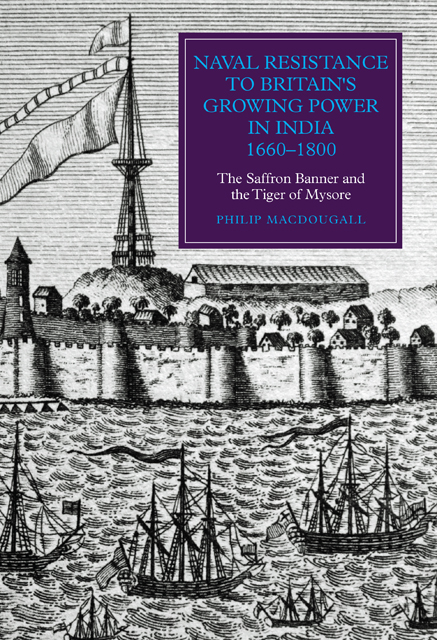 Naval Resistance to Britain's Growing Power in India, 1660–1800
Naval Resistance to Britain's Growing Power in India, 1660–1800 Published online by Cambridge University Press: 23 February 2023
The City is situated by the side of a pleasant river, which falls into the Indian Sea over a bar. This river is navigable for ships of large burthen, where they have the benefit of building and repairing ships with the same convenience as we have in England. The Moors build very complete ships; which the princes of Arabia frequently purchase.
Clement Downing (1737)
For the Mughals, Surat was the port where they developed a navy of not inconsiderable importance, with vessels built here that would eventually come to adopt many European technical developments. On a few occasions only were these to be directly employed against either the Portuguese or any other European naval force. Instead, they were used to defend the empire against internal indigenous opposition. As for both the Dutch and English, the two European nations that the Mughals identified as potential allies in their attempt to undermine the Portuguese, Surat was to provide them with important shore-based facilities that included not just trade factories but a defended port that permitted them to maintain and repair ships. In addition, and usefully allowing the Mughals to gain an insight into methods of European ship construction, there were facilities at Surat used for the building of ships for the European trading nations.
Surat first emerged as a major port city during the late fifteenth century when it began to contribute significantly to the wealth of the Sultanate of Gujarat. It lies on the Tapi River some fourteen miles before it drains into the Gulf of Cambay. In 1572 Surat was brought into the rapidly expanding Mughal Empire, captured by Jalāl ud-Dīn Muḥammad Akbar, otherwise known as Akbar the Great, who, as the third Mughal Emperor, ruled from
To save this book to your Kindle, first ensure no-reply@cambridge.org is added to your Approved Personal Document E-mail List under your Personal Document Settings on the Manage Your Content and Devices page of your Amazon account. Then enter the ‘name’ part of your Kindle email address below. Find out more about saving to your Kindle.
Note you can select to save to either the @free.kindle.com or @kindle.com variations. ‘@free.kindle.com’ emails are free but can only be saved to your device when it is connected to wi-fi. ‘@kindle.com’ emails can be delivered even when you are not connected to wi-fi, but note that service fees apply.
Find out more about the Kindle Personal Document Service.
To save content items to your account, please confirm that you agree to abide by our usage policies. If this is the first time you use this feature, you will be asked to authorise Cambridge Core to connect with your account. Find out more about saving content to Dropbox.
To save content items to your account, please confirm that you agree to abide by our usage policies. If this is the first time you use this feature, you will be asked to authorise Cambridge Core to connect with your account. Find out more about saving content to Google Drive.